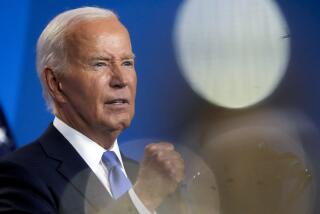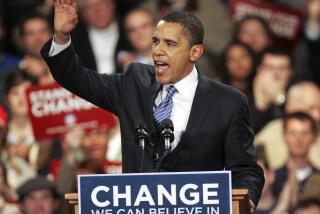Iowa Is a Fine Place to Take the Candidates for a Test Drive
- Share via
From a distance, it is not hard to come to the same conclusion that then-Vermont Gov. Howard Dean reached on television four years ago: The Iowa caucuses are a waste of time and “dominated by the special interests.”
Voters in other states have long wondered why Iowa and, for that matter, New Hampshire, came to play such a near-sacred role in the presidential nomination process. Both Democratic and Republican national party rules prohibit any other states from having a national delegate-selecting caucus or primary before Iowa and New Hampshire.
Though the New Hampshire primary dates back to 1920, it became a ritual in 1952. The Iowa caucuses came of age in 1976, when Jimmy Carter practically moved to the state, spending 110 days there in 1975. The victory of this little-known, scantly funded former governor of Georgia over better-known and better-funded candidates in this previously overlooked event shocked political reporters and the Democratic Party establishment. It gave Carter a burst of momentum that helped him win the New Hampshire primary five weeks later.
Critics have long suggested that Iowa and New Hampshire, the first two states to hold primaries or caucuses, and historically the most important ones, are hardly representative of the nation as a whole. After all, largely rural Iowa and quirky, small-town New Hampshire are 94% and 96% white, respectively, hardly a microcosm of the United States.
But it also isn’t hard to reach a different conclusion, as Dean apparently did after spending a great deal of time campaigning in Iowa. Although it’s true that neither Iowa nor New Hampshire is truly representative of the country, the two states play an important role in the nominating process that would be difficult to replicate elsewhere.
Voters in Iowa and New Hampshire do not find it odd to go to community centers or American Legion and VFW halls several nights a week, or to spend a weekend morning or afternoon listening to candidates, asking questions or even pursuing a follow-up question in the parking lot afterward.
The old story about the New Hampshire voter who was asked whether he was going to support a candidate saying, “I’m not sure, I’ve only met him twice,” is only a partial exaggeration. Many get a chance to meet almost every presidential candidate at least once or twice, looking them in the eye and taking their measure. Not very likely that this could happen in California or any other heavily populated state.
The strength and importance of the Iowa caucuses and New Hampshire primary is that the normally all-important television advertisements are much less influential in these contests. Voters in these states like to kick the tires, get behind the wheel, take a test drive. Though some of these people lack the sophistication of the East or West Coast, they often display common sense and maybe have a hypocrisy meter that is as sensitive as anywhere else.
It’s not to say that no other small-to-medium-size state could play the same role. But it would take several presidential elections for voters in those states to realize that they were in a position to screen candidates before the contest moved to states where 30-second television advertisements reign supreme and bloodless candidates with little or no personal touch with average folk could win with a catchy slogan.
If larger states like California, New York, Texas or Ohio were to go first, by necessity the campaigning would be all electronic, impersonal affairs. The old adage that a political rally in California is three people on a sofa watching television is not much of an exaggeration.
The people of Iowa and New Hampshire see their events as their quadrennial 15 minutes of fame, their turn to go from relative obscurity to importance -- however brief. Not only do they compare the candidates running against one another this year, but many are old enough and observant enough to compare this year’s crop of contenders with those from four or eight or 12 years ago.
Though hardly perfect, the system does seem to work. Nine of the last 10 major party presidential nominees were winners of either the Iowa caucuses or the New Hampshire primary. The one exception was Bill Clinton in 1992, when the candidacy of Sen. Tom Harkin of Iowa made the Iowa caucuses a moot event and when Gennifer Flowers held a news conference, playing a recording of telephone conversations with Clinton corroborating her story that the two had had a long-standing love affair. Call me old-fashioned, but that probably was what gave Paul Tsongas his 8-point victory in New Hampshire over Clinton.
Dean’s criticism in 2000 of the heightened influence of special interests on the caucus does have merit. Organized groups, whether they are pro-choice or pro-life, pro- or anti-gun control, labor or business, tax or anti-tax, can have an effect in the Iowa caucuses, but they also have an enormous influence in the other 49 states. When races become hotly contested, it tends to minimize these effects. For me, the personal touch is worth the cost.
Every time I come home after visiting one of these two states during a presidential campaign season, I can’t think of a better way of doing it.
More to Read
Get the L.A. Times Politics newsletter
Deeply reported insights into legislation, politics and policy from Sacramento, Washington and beyond. In your inbox three times per week.
You may occasionally receive promotional content from the Los Angeles Times.










